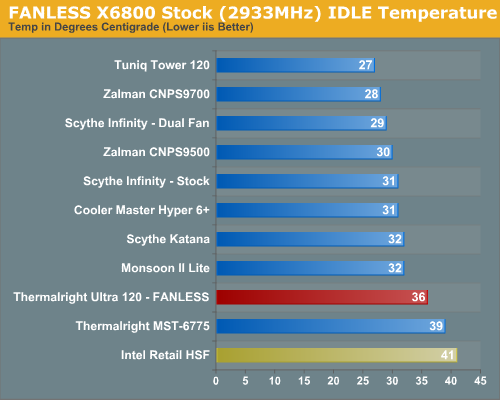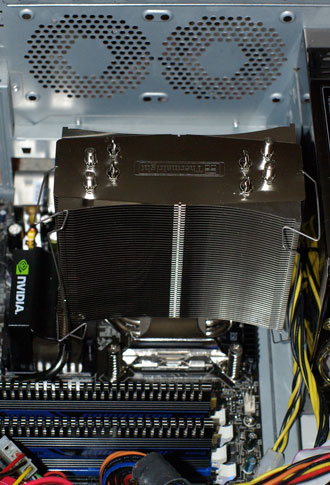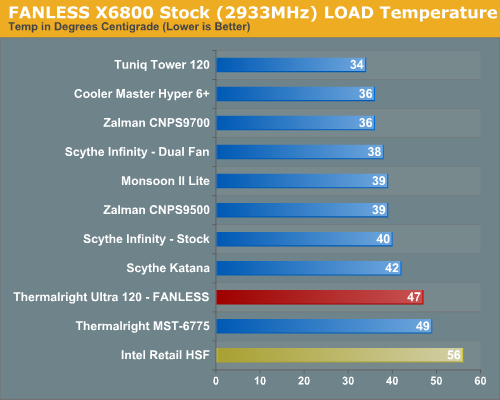Thermalright Ultra 120: Elegant, Fanless and Efficient Cooling
by Wesley Fink on March 5, 2007 12:05 AM EST- Posted in
- Cases/Cooling/PSUs
Fanless Cooling
The Ultra 120 is based on the design of the fanless HR-01, so we were interested in seeing how the Ultra 120 performed without a cooling fan.

Even without a cooling fan the Ultra 120 managed to keep the CPU cool at idle. This performance is actually a bit better than the stock Intel retail HSF which does have a fan. Where the very good Intel stock cooler keeps the X6800 at 41C at idle, the fanless Ultra 120 can manage an even better 36C, with no fan at all.

Cooling efficiency of the fanless Thermalright Ultra 120 was also compared under load conditions at stock speed by continuously looping a benchmark test of Far Cry. The Far Cry River demo is looped for 30 minutes and the CPU temperature is captured at four second intervals with the NVIDIA monitor "logging" option. The highest temperature during the stress test is then reported. Momentary spikes are ignored, as we report a sustained high-level temp that you would expect to find in this recording configuration.

The temperature after 8 minutes of heavy load testing reached 47C. During the 30 minutes of testing the Ultra 120 never exceeded 62C. It also quickly returned to 48C after the stress testing, but it took quite a while to return to the idle 36C. This demonstrates that our case setup is very poor for a fanless CPU cooler.
Our stock OCZ PowerStream 520 is a poor design for a fanless cooling system. Thermalright recommends a power supply with a down-facing fan (one that removes air from the CPU area) be used for cooling for the fanless HR-01. Many other power supplies use this design and they would definitely improve fanless performance of the Ultra 120. Therefore our fanless test results should be considered absolute worst case.
Fanless Overclocks
Fanless benchmarks were also run at two moderate overclocks. At 3.2GHz (12x267 at default voltage), temperatures started at 40C. We measured temperatures after each 8 minutes of load test and found maximum temperatures at 58C-67C-71C-82C. The system never failed even though temperatures as high as 82C were reached during testing. It is again clear our case design is not exhausting enough air for this cooler in fanless operation while it is overclocked.
Tests were also run fanless at 3.5GHz (13x277 at stock voltage). Idle at 3.5GHz fanless was 50C. 8-minute interval stress temperatures were 69-75-81-fail. We are confident that a better ventilated case and a power supply with a down facing fan above the CPU would improve air flow enough for day-in and day-out operation at moderate overclocks with a fanless Ultra 120. With no case fans, no CPU fan, and a power supply that exhausts air only to the rear there was nothing to adequately remove heat from the case/CPU. With a reasonable case/PSU setup for fanless use you will likely get performance levels close to our first set of load measurements.
It is clear from the Ultra 120 testing without a fan that this heatsink can easily cool a Core 2 Duo at stock speed without a fan. It also will likely handle moderate overclocks at stock voltages. It is important to use a power supply with a CPU down-facing fan for best fanless performance. Case exhaust fans would also help, as well as rear fan ducts such as those supplied on the Thermalright HR-01 fanless cooler.
For those whose main concern with cooling is low noise the ability to cool with no fan at all is hard to beat. Fanless CPU cooling requires careful attention to airflow in the case and the design of the power supply, but the reward is the lowest noise possible with air cooling.
The Ultra 120 is based on the design of the fanless HR-01, so we were interested in seeing how the Ultra 120 performed without a cooling fan.

Even without a cooling fan the Ultra 120 managed to keep the CPU cool at idle. This performance is actually a bit better than the stock Intel retail HSF which does have a fan. Where the very good Intel stock cooler keeps the X6800 at 41C at idle, the fanless Ultra 120 can manage an even better 36C, with no fan at all.

Cooling efficiency of the fanless Thermalright Ultra 120 was also compared under load conditions at stock speed by continuously looping a benchmark test of Far Cry. The Far Cry River demo is looped for 30 minutes and the CPU temperature is captured at four second intervals with the NVIDIA monitor "logging" option. The highest temperature during the stress test is then reported. Momentary spikes are ignored, as we report a sustained high-level temp that you would expect to find in this recording configuration.

The temperature after 8 minutes of heavy load testing reached 47C. During the 30 minutes of testing the Ultra 120 never exceeded 62C. It also quickly returned to 48C after the stress testing, but it took quite a while to return to the idle 36C. This demonstrates that our case setup is very poor for a fanless CPU cooler.
Our stock OCZ PowerStream 520 is a poor design for a fanless cooling system. Thermalright recommends a power supply with a down-facing fan (one that removes air from the CPU area) be used for cooling for the fanless HR-01. Many other power supplies use this design and they would definitely improve fanless performance of the Ultra 120. Therefore our fanless test results should be considered absolute worst case.
Fanless Overclocks
Fanless benchmarks were also run at two moderate overclocks. At 3.2GHz (12x267 at default voltage), temperatures started at 40C. We measured temperatures after each 8 minutes of load test and found maximum temperatures at 58C-67C-71C-82C. The system never failed even though temperatures as high as 82C were reached during testing. It is again clear our case design is not exhausting enough air for this cooler in fanless operation while it is overclocked.
Tests were also run fanless at 3.5GHz (13x277 at stock voltage). Idle at 3.5GHz fanless was 50C. 8-minute interval stress temperatures were 69-75-81-fail. We are confident that a better ventilated case and a power supply with a down facing fan above the CPU would improve air flow enough for day-in and day-out operation at moderate overclocks with a fanless Ultra 120. With no case fans, no CPU fan, and a power supply that exhausts air only to the rear there was nothing to adequately remove heat from the case/CPU. With a reasonable case/PSU setup for fanless use you will likely get performance levels close to our first set of load measurements.
It is clear from the Ultra 120 testing without a fan that this heatsink can easily cool a Core 2 Duo at stock speed without a fan. It also will likely handle moderate overclocks at stock voltages. It is important to use a power supply with a CPU down-facing fan for best fanless performance. Case exhaust fans would also help, as well as rear fan ducts such as those supplied on the Thermalright HR-01 fanless cooler.
For those whose main concern with cooling is low noise the ability to cool with no fan at all is hard to beat. Fanless CPU cooling requires careful attention to airflow in the case and the design of the power supply, but the reward is the lowest noise possible with air cooling.










30 Comments
View All Comments
Wesley Fink - Monday, March 5, 2007 - link
I have changed the comment to "remove" air.A quick glimpse at www.newegg.com shows a number of power supplies with down-facing fans. Examples are the the OCZ GameXStream 700 at http://www.newegg.com/Product/Product.asp?Item=N82...">http://www.newegg.com/Product/Product.asp?Item=N82..., the Seasonic at http://www.newegg.com/Product/Product.asp?Item=N82...">http://www.newegg.com/Product/Product.asp?Item=N82..., the Coolermaster 550W http://www.newegg.com/Product/Product.asp?Item=N82...">http://www.newegg.com/Product/Product.asp?Item=N82..., the Thermaltake 550w at http://www.newegg.com/Product/Product.asp?Item=N82...">http://www.newegg.com/Product/Product.asp?Item=N82..., the Raidmax at http://www.newegg.com/Product/Product.asp?Item=N82...">http://www.newegg.com/Product/Product.asp?Item=N82..., and the Enermax at http://www.newegg.com/Product/Product.asp?Item=N82...">http://www.newegg.com/Product/Product.asp?Item=N82....
Even at the low end you can find down-facing fans such as the Xion 500W, $29.95 after rebate at http://www.newegg.com/Product/Product.asp?Item=N82...">http://www.newegg.com/Product/Product.asp?Item=N82..., the house brand Rosewell 400w at http://www.newegg.com/Product/Product.asp?Item=N82...">http://www.newegg.com/Product/Product.asp?Item=N82..., and the Sparkle 350W at http://www.newegg.com/Product/Product.asp?Item=N82...">http://www.newegg.com/Product/Product.asp?Item=N82....
Fans which remove air from the CPU area are VERY common and not difficult to find.
johnsonx - Tuesday, March 6, 2007 - link
I think you misunderstood the gist of my comment, but your correction to the article is indeed correct. I was making the point that the bottom fan of a power supply does not BLOW air onto the CPU area, rather it intakes air FROM that area. I'm well aware there are numerous such power supplies available (personally I prefer the ones that have both a bottom and a rear fan, but there are valid points both ways on that debate).Sometimes I try to be too creative in my phrasing, thus obfuscating my central point beyond recognition.
nilepez - Monday, March 5, 2007 - link
Since you're reviewing HS, perhaps you need to test them all with the same fan (assuming they take the same fan size). Obviously some come with fans, and you'd want to test with the stock fan, but to make things equal, I think you need to pick a fan (Skythe, Noctua, Panaflo et al.) and test them all with that fan as well. Only then will we know what the best HS is.My guess is that Thermalright would still be up there, as they're generally one of the best HS makers (if not the best) out there.
Rocket321 - Monday, March 5, 2007 - link
I would love to see a review of the Ultra 90 you mentioned on page 2. I'm hoping to find something a little lighter than these highend coolers without moving into the budget sector.ADDAvenger - Monday, March 5, 2007 - link
I'd be interested in a review of that as wellorion23 - Monday, March 5, 2007 - link
Thank you guys for another great review! Great Job!It's nice that these coolers are being tested with new setups (C2D) unlike many other sites that choose to test with "old hardware".
I've always been a fan of the Thermalright Ultra 120 which BTW has kept my 4ghz overclock (E6600) idling @ 28-35 and 50c under load. I tried a Tuniq Tower but the results were @ least 5c higher with the Tuniq!
Go Thermalright!
jonman03 - Tuesday, March 6, 2007 - link
I have to agree, we get alot of requests for these on our custom systems. Great cooler, looks great in windowed cases. What else could you ask for?http://www.plugcomputers.com">Custom Gaming Computers - Plug Computers
1111111 - Monday, March 5, 2007 - link
A few minutes with a hacksaw works fine to remove a section of the fan posts. That's what I ended up doing with my Thermalright Ultra-120/Yate Loon D12SL-12.
Wesley Fink - Monday, March 5, 2007 - link
Your suggestion works, and the hack saw works best if you have a vise to hold the fan while you saw. A jigsaw melts the plastic as it moves too fast and creates too much heat for the plastic as it cuts - so it does not work as well.HOWEVER, this is a review of a heatsink that does not come with a fan and the special fan post requirements need to be pointed out. Not everyone wants to do shop work on a fan before it will mount on a heatsink.
hiepbiz - Monday, March 5, 2007 - link
I wonder why you tested only the single fan setup. The design of the Ultra 120 definitely suggests a perfect push and pull combo. Also, you didn't mention about the mounting surface of the Ultra 120. It's known that Ultra 120 has a pretty much uneven surface (observable with unaided eyes). I had to lap mine to not only expose the copper surface but also to make the surface flat.The reason I brought this up because there are people that don't care about noise and would prefer a very high-performance air-cooling. If the dual setup and a more even mounting surface would help, I would think it would put the Ultra 120 head and shoulder above the Tuniq Tower for these people (that would include me).
I happened to own both Tuniq and Ultra 120, and I would say I prefer the flexibility the Ultra 120 offers.
Other than some of the minor points that I've pointed out, I would say that this review (and other recent HSF reviews) is an excellent one. Keep up the good work. BTW, I wonder when you're gonna do a piece on the Coolit Freezone.